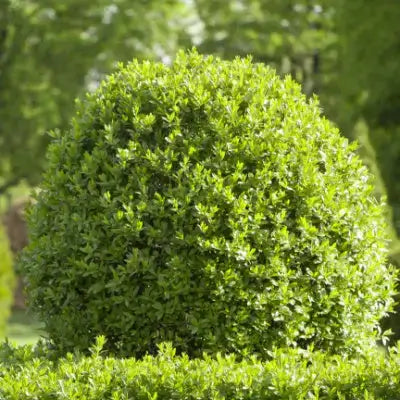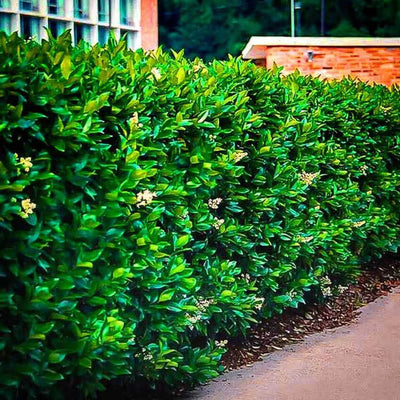Privet Wax Leaf Creates Privicy Without The Hassle - The Definitive Guide
Introduction
If you want to add natural barriers to your garden or yard the Wax Leaf Privet is an excellent choice. This evergreen shrub not only offers privacy but is also an astonishing addition to the landscape. Its beauty and easy maintenance makes it ideal for any garden. It is also perfect for people wanting to seclude themselves in their garden. It is a hedge shrub that is versatile and reliable.
This article will define in detail the features, care, and impact on the environment of the Wax Leaf Privet. Additionally, we will provide recommendations of other plants that will complement the Privet hedges.

What is Wax Leaf Privet?
Wax Leaf Privet (Ligustrum japonicum) is a shrub that grows in East Asia, mainly in Japan and China, evergreen in nature and boasts beautiful, luxuriant foliage that captivates landscapers. It is easily adaptable to diverse conditions, including full sunlight and partial shade, and grows rapidly, making it a perfect choice for natural privacy fences and hedges.
Marked by opulent foliage as well as dark glossy leaves, the Wax Leaf Privet provides the ideal compliment to any property and also provides the sought-after privacy barrier that so many homeowners appreciate.
Why choose Wax Leaf Privet?
Bestselling Privacy and hedging plant.
Foliage Retention: No need to worry about privacy. These plants will keep on growing and retaining leaves all year.
Growth: Growth rate 1-2 feet annually.
Urban Living: Excellent for reducing noise and a good barrier for distracting areas.
Maintenance: Minimal. Cuts can keep the shrub under control and minimal will be needed for the plant to bounce back.
Where Do Wax Leaf Privets Grow?
If gardening is a hobby that makes you anxious, don't worry. It is perfectly okay to plant Wax Leaf Privet in many different areas. It can do well in both full sun and can tolerate partial shade, although the more sun the faster it will grow. For areas that do not have a water supply, once the plant is stabilized it can tolerate drying periods.
These species may grow in soils that are well-drained, including loam, clay, and sand. Unlike most other species, the Wax Leaf Privet can tolerate numerous habitats, including urban areas, where it may be planted along fences, in fence rows, or in almost any other location where a natural privacy screen is desirable.

Care Guide: Wax Leaf Privet
As is the case with the majority of the shrub species, Wax Leaf Privet does require some level of upkeep for it to maintain a desired appearance. Use the effective and straightforward maintenance tips outlined below:
Pruning: Wax Leaf Privet should be pruned least 2 to 4 times in a year to ensure the bush shape is maintained. Pruning can be conducted in the winter or early Spring, even before the new growth begins. This helps the hedge to remain dense.
Fertilization: Little is needed, but the application of balanced fertilizer every season ensures a healthy plant and vigorous growth
Watering: Wax Leaf Privet needs to be watered regularly in the first year to help it establish itself in soil. For the summertime, in hot, dry conditions, watering may be needed more often.
Physical Characteristics of Wax Leaf Privet.
Leaves: These leaves are dark green and glossy with a waxy coating. The leaves are oval shaped of lance-like and are between two to four inches in length. These leaves are dense in nature and provide excellent coverage to a plant which makes it ideal for borders or hedges.
Flowers: This plant blooms in small, unique clusters, with each having a distinctive, dainty and fragrant white flower. This plant’s abundant blooms are a magnet for bees and butterflies, which are invaluable for enhancing biodiversity in your garden in late spring or early summer.
Berries: Shrub after flowering, small black berries appear in the fall, which enhances interest to your landscape.
Environmental Benefits of Wax Leaf Privet.
Though the beauty and versatility of Wax Leaf Privet are second to none, it does come with a cost to the public and the environment if not taken care of properly. Always be conscious of the following:
Invasive Potential
Wax Leaf Privet is known to be invasive in newly settled regions. Its rapid growth and dense foliage allows it to compete with native plants, which threatens biodiversity in the ecosystem.
Control Measures
If you live in regions where the plant can be invasive, it is your responsibility to curb the spread by aggressively mowing and pruning the plant, and removing the berries before they can spread.
Cultural Significance of Wax Leaf Privet
Besides being good for landscaping, Wax Leaf Privet holds cultural value, especially in Chinese and Japanese gardening:
Chinese Culture
Wax Leaf Privet is a sign of good fortune and prosperity because of its cultural symbolism. It is common to plant it around homes and temples to ward off ill fortune and to invite good vibrations.
Japanese Gardens
Wax Leaf Privet is widely considered to be one of the most important plants in Japanese gardens because of its versatility and ability to take on almost any shape. It is also a common.feature of Japanese landscaping and tends to be a hedge or a private screen.
Plants That Complement Wax Leaf Privet
Besides the beauty of the Wax Leaf Privet on its own, it is also recognized to be accompanied by many other plants that increase its beauty and purpose. Below are a few plants that go well with it:
Boxwood (Buxus)
Boxwood is a common plant used for formal hedging, and its compact, growth habit, and dense foliage makes it an appropriate companion to Wax Leaf Privet.
Holly (Ilex)
With its evergreen leaves and colorful berries, Holly not only adds contrast to the dark green leaves of the Wax Leaf Privet, it also brings beauty all year round.
Liriope
Compact perennial border plant. Groundcover under Wax Leaf Privet hedges.
Natural privacy using Wax Leaf Privet
For those wanting to create an elegant space just for themselves, this plant is a wonderful and easy choice, giving the gardener privacy while requiring very basic care. Being a widely liked plant, it works well as hedges, boundaries, or a single feature in a lot, enhancing the overall landscaping design.
Experience the best of Wax Leaf Privet and other plants by visiting TN Nursery and designing your dream garden.
FAQs
What are the benefits of Wax Leaf Privet?
The Wax Leaf Privet has many benefits including being extremely versatile. It can withstand various climate conditions and requires minimal maintenance. It can help create an impactful dense privacy barrier. It grows rapidly and acts an excellent sound barrier. It can withstand other soil conditions which is an ideal plant for low maintenance gardeners and acts as an excellent privacy barrier by retaining all its leaves which acts as an excellent plant all through the seasons.
What is the fastest growing natural privacy fence?
Wax Leaf Privet is one of the fastest-growing natural privacy plants. It can grow up to 1-2 feet per year when left unchecked, making it a great choice for quickly establishing a hedge or privacy screen. Its dense, evergreen foliage ensures privacy throughout the year, and it can easily be shaped to suit your landscaping needs.
What are the negatives of privet hedge?
The primary concern with the Wax Leaf Privet is that in some areas it is considered as an invasive species. It can quickly become a "plant bully" and smother out the native vegetation and animal life which in turn can greatly decrease the biodiversity. It is recommended that it is cut back and managed to mitigate the invasive potential. It is important that it is managed well as it can easily become a dominant species in a plont.onitor its growth to prevent it from becoming too dominant in your garden.
What plant is best for blocking neighbors?
The Wax Leaf Privet is primary recommended plant to block out neighbors. Besides that there is the BLockwood, Holly, and Arborvitae which are all highly recommended plants to provide privacy and also enhance the beauty of your garden area.
Do wax leaf privets attract bees?
Yes, Wax Leaf Privet produces small, fragrant white flowers in late spring and early summer that attract pollinators like bees and butterflies. These flowers help enhance the biodiversity in your garden and support local pollination efforts.
Is wax leaf privet invasive?
In some areas, wax-leaf privet can be invasive, especially if there is sufficient space for growth and no controls on competition with native species. To stop such situations emerging, it is necessary to control the growth wax leaf privet through regular pruning, and also to remove any fruits or berries that can be dispersed and propagated.





